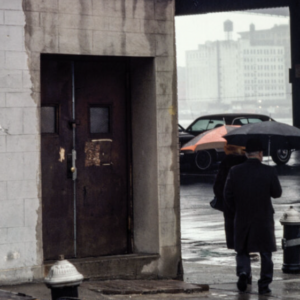Inside the hospice center two days before my partner Violet’s grandmother’s funeral, the quiet shuffle of the death vigil has begun. Violet’s grandmother lies dying in a bed and I’m alone with Violet’s family.
Her grandmother didn’t want Violet to disrupt her studies to come home from Germany since she had just visited home two weeks ago, before her grandmother was diagnosed, before anyone knew she was sick. The tumors grew so rapidly in her lungs that Violet’s grandmother hadn’t even gone to a doctor, thinking she just had congestion or chest pain, some affliction she could walk off.
Earlier in the afternoon, I walked off the cement pathways of the neatly manicured lawn into the woods behind the hospice center to be alone and escape the awkward silence of the hospice room. The hospice center is nestled flat in the valley between Black Hand sandstone cliffs, the highest peaks of which jut hundreds of feet above the ground.
In the shade, the hot autumn air cools as it dips into the valley of Pleasant Run where it flows behind the hospice center. Water spiders snap across the surface, muddy from rains. Blue jays, chimney swifts, and eastern phoebes flit from branch to branch, plunging toward the water before darting into the narrow lick of blue sky. Unlike many of the streams in Appalachia, Pleasant Run is free of acid mine drainage. I stick my hand in, feel its force, its age, the layers of stone carved by its ceaseless flowing, the connection of this small region to others.
The mutual unknowing, this history, hovered between us in that silent hospice room, a fogged gorge, a crumbling bridge.Violet’s family remains a mystery, even after seven years together. Violet and I had been evading and denying each other since the beginning of our relationship. I told Violet that I was transgender when we met. I didn’t know the depths of her bipolar disorder, or the severity of her substance abuse. I couldn’t see then how these would worsen or the ways I—and my nascent girlhood—would become buried under the weight of them.
During our years together, we sometimes lived together, sometimes apart. We were sometimes in the same country, sometimes not. We were sometimes happy, but mostly not. I didn’t recognize it then, but we were both creating barriers to justify and insulate our feelings, to avoid blame. I didn’t think I could walk away.
The mutual unknowing, this history, hovered between us in that silent hospice room, a fogged gorge, a crumbling bridge. I wanted an explanation for why I was at the hospice center, but I never found one, and I have blank spots in the timeline where I found the experiences too hard to hold. I want to fill in the gaps, temper the memories, imbue them with a sense of order and meaning.
So, I turn to the technical prose of nineteenth- and twentieth-century accounts of death and dying in central Appalachia. I hope to borrow some of the surety of their functionalism to explain my peculiar teleology.
Historically in Appalachia, communities provided food to allow the family to keep watch over their dying loved one. During this death vigil or “sitting up,” extended family, neighbors, and fellow churchgoers would bring food, coffee, and tea to the mourning family. The provision of food lifts a burden from the grieving family.
The death vigil most commonly practiced in Appalachia dates to medieval and Renaissance Europe, when a continuous watch was held at the bedside of the dying until they passed, and subsequently until other mourners had a chance to visit. Some vigils were large affairs; others were only for those invited by the family. The vigil could last months, weeks, days, or hours, depending on how long death took to arrive.
The deathwatch purportedly served many functions, allowing time for family members and neighbors to help cook, perform household chores, and tend to children, animals, and crops. Visitors came to assuage the loneliness of the grieving family, to show respect, to bid farewell.
In Appalachia, it was an unthinkable social taboo to not show up for the deathwatch, even if long travel was required. There was a physical practicality to the deathwatch. Houses had to be heated or cooled and bodies, before and after death, needed constant care.
In a process called “laying out,” which was conducted before rigor mortis—commonly called “cold death” or “stiffening”—set in, the body was placed on a cooling board, which was sometimes just a plain wooden board covered in a sheet or a door taken off its hinges.
The corpse was bathed, the face and extremities washed with lye soap and water or a cloth dipped in soda water, camphor, and vinegar or alcohol to prevent discoloration.
The hair was combed and the face shaved if needed. A cloth was tied around the head and under the chin to keep the mouth from falling open. If the eyes were not closed before rigor, weights, usually coins, would be placed on the eyelids to give the corpse the appearance of sleep. In warm weather, mourners would fan the corpse to keep it cool. The overnight watch was necessary to protect the corpse from flies, rats, and cats.
The death vigil served an important social function. Attending a deathwatch was a way to be seen, to begin the cycle of reciprocity so that when the day came, the community would return the favor. The death vigil was also a spectacle, an event to be witnessed and later recounted to others.
Attitudes toward death have changed since the nineteenth century. Sickness and death have largely been hidden away in medical facilities, the act of care transferred from family and friends to trained medical staff. The home is no longer the most common domain of death.
No part of this moment feels like grace for Violet’s grandmother or for her family. Mercy maybe, but not grace.Furthermore, technologies such as temperature-controlled rooms and embalming have slowed the process of decomposition and kept scavengers away. Mourners are now mostly absent from the process of corpse care. The immediate family is thus freed to handle domestic affairs. For the most part, friends and community members now visit after death at the showing or the funeral, or they simply send condolences. Now social proximity dictates whether friends and community members should attend to the bereaved, whether their presence will burden the family. The taboo has shifted from not being in the proper place to not knowing it.
Violet’s aunt texts me to come back inside the hospice center. I walk past the garden, wet with bloom, to the sliding glass door of Violet’s grandmother’s room and look through the window. The family huddles around a tiny pale body with hair wispy as an acanthus bush left to grow unnoticed. I step inside and Violet’s aunt takes my hand.
The priest performs last rites at her bedside and the family responds in unison to the prayer. As Violet’s grandmother starts to slip away, the family begins to sing “Amazing Grace.”
I grew up the child of a pastor in an evangelical church, an upbringing that taught me how to function in awkward situations and the words to dozens of hymns that people sing during them. I listen as the passages stucco with choked diaphragms, dry mouths, spongy, salted tears. I mouth the words I’ve mouthed a thousand times in church.
No part of this moment feels like grace for Violet’s grandmother or for her family. Mercy maybe, but not grace. No elegance rests in the room, no honor or refinement fills its stillness. Grace could be the goodwill we offer her, the way I play the good neighbor. But there’s no grace in it for me either.
I want more out of this moment, more out of the separation of death, not this ceasing, this stasis where nothing moves on, nothing moves, nothing moves me. I want the grace of the song to rid me of my shame. I want to leave but I’m held in place by hands pulling tighter as I try to move away from death unfolding in front of me.
The family trails off into silence when the doctor shakes his head in a gesture of certainty. Violet’s aunt releases my hand, wipes her nose, and stifles her sobs as she arranges the flowers on the stand beside her mother with exactitude.
The family members wipe their faces, straighten their clothes, and line up beside the bed to prepare for the traditional photo with the deceased sitting up in bed.
I know this tradition; I’ve seen pictures of older family members standing around the deathbeds of my ancestors. I try looking anywhere but at Violet’s grandmother or her family. I close my eyes, conjuring the photo albums that line the top of my grandmother’s old closet and try so desperately to transport myself into a photograph of the family in which I belong—a birthday party, sitting around my grandmother’s all-white Christmas tree, behind the barn with my grandfather, in a tree with my cousin, at my grandmother’s funeral.
I am a ghost in the corner of the hospice room, flickering, captured before I can fade away.
Traditionally in Appalachia, the records describe, the mourning family decided how to arrange the corpse and room based on the specifics of the death culture in which they took part. The positioning of the corpse was vital.
The legs were extended, the arms folded, the hands placed on top of the chest, the head and face held in place by pillows to keep it facing forward. These standards, however, were not universal. The gender, age, and status of the corpse translated to different bodily ideals and thus different body positions.
Postures were similarly manipulated to give the illusion of sleep to ensure rest for the dead. Objects were used to enhance the positioning of the corpse. Sometimes the intent was to obscure it or to hide it altogether—for example, by covering the body with a blanket, placing flowers on it, or shrouding it.
The laying out of the corpse was accompanied by elaborate ritual practices and performances. In parts of Appalachia, traditional corpse decorations included personal effects, toys, shells, rocks, and pottery sherds. Weeds, wildflowers, crepe paper flowers, and homemade wreaths gradually gained popularity as a form of decoration in the United States after the mid-nineteenth century.
Artists commonly portrayed the dead in watercolor paintings distributed to the mourning families. When photography came to Appalachia, some adopted it as a method to capture the memory of loved ones. Feelings about photography at the time were mixed. Some in the region were superstitious about it; others found it entirely mundane.
Photographs were taken in a variety of settings: inside the house, outside in a yard or field, at the grave before burial. Photographers were hard to come by in the nineteenth and early twentieth centuries, so photos were rarely taken while the person was alive. In this regard, photographs also furnished evidence the person was dead and served as a memento mori, a way to remember the dead and help in the grieving process. Some photographs were kept by family members while others adorned tombstones.
Our understanding and experience of death affects how we view the corpses we encounter. If our experiences with corpses are few, they seem alien, disturbing, unnatural. Conversely, if the normal rituals of daily life include corpses—living bodies in contact with dead ones—encountering bodies becomes mundane.
I never got to know Violet’s grandmother, so the corpse I encounter in the hospice center feels only distant and cold. Her body position signals only death.
I hear the clicks, the shifting, the adjustments in the room around me as I try to keep myself in my grandmother’s photo albums, safe in a plastic refuge. But someone nudges me to open my eyes for the photo. I look out from my interior photographs to the reality in front of me, the creation of a photo I don’t want to see, a photo I won’t forget.
In a hospice center on the banks of a quiet creek muddy from rain, a dead woman sits up in bed, surrounded by her family. A ghost hovers in the corner next to them. The lens focuses, the shutter clicks, but no one smiles—they are sentinels guarding the dead and the memories of the living.
___________________________

Adapted from Tar Hollow Trans by Stacy Jane Grover. Copyright © 2023. Reprinted with permission of the publisher, University of Kentucky Press.



